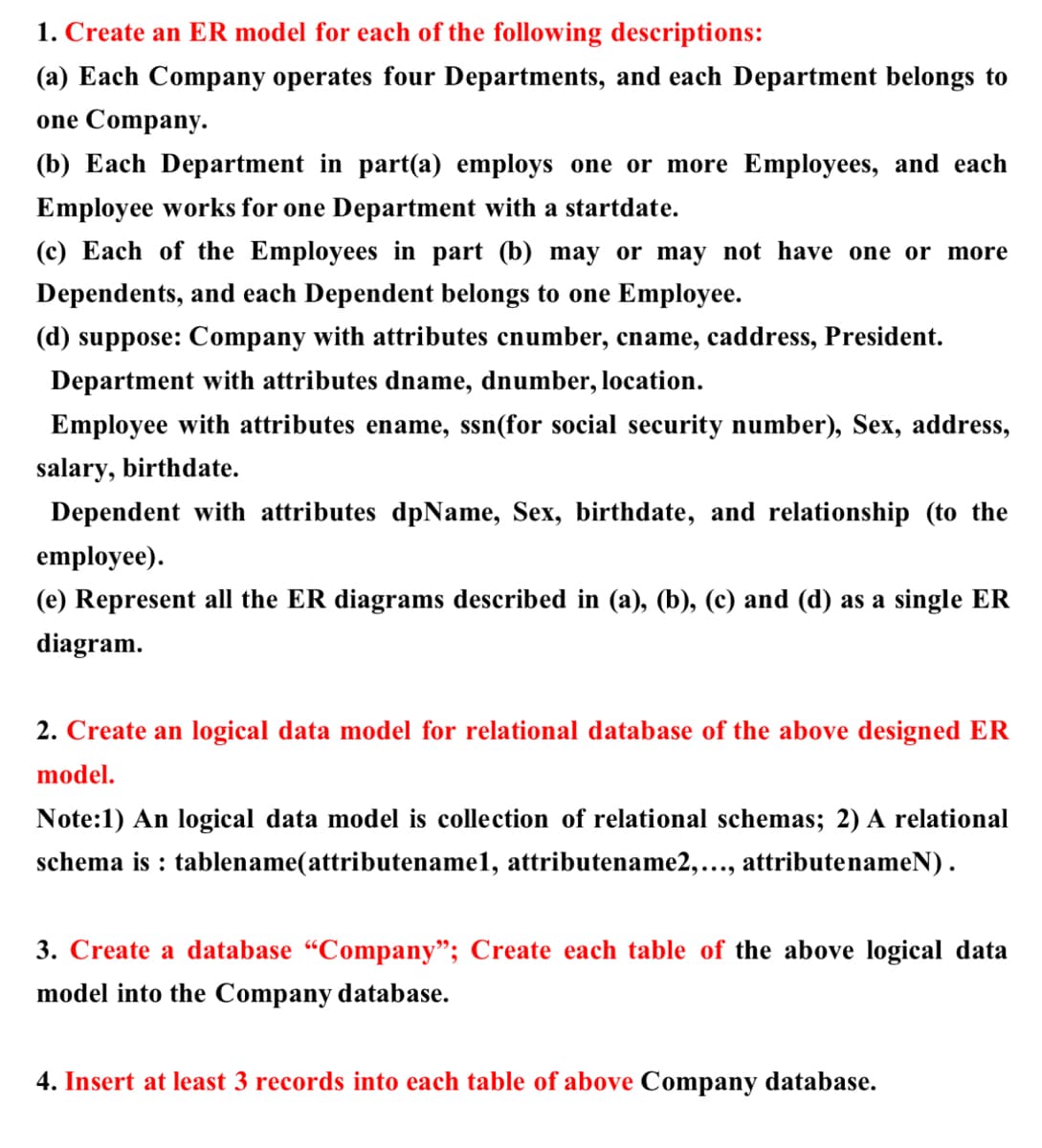1. Create an ER model for each of the following descriptions: (a) Each Company operates four Departments, and each Department belongs to one Company. (b) Each Department in part(a) employs one or more Employees, and each Employee works for one Department with a startdate. (c) Each of the Employees in part (b) may or may not have one or more Dependents, and each Dependent belongs to one Employee. (d) suppose: Company with attributes cnumber, cname, caddress, President. Department with attributes dname, dnumber, location. Employee with attributes ename, ssn(for social security number), Sex, address, salary, birthdate. Dependent with attributes dpName, Sex, birthdate, and relationship (to the employee). (e) Represent all the ER diagrams described in (a), (b), (c) and (d) as a single ER diagram. 2. Create an logical data model for relational database of the above designed ER model. Note:1) An logical data model is collection of relational schemas; 2) A relational schema is : tablename(attributename1, attributename2,..., attributenameN). 3. Create a database "Company"; Create each table of the above logical data model into the Company database. 4. Insert at least 3 records into each table of above Company database.
1. Create an ER model for each of the following descriptions: (a) Each Company operates four Departments, and each Department belongs to one Company. (b) Each Department in part(a) employs one or more Employees, and each Employee works for one Department with a startdate. (c) Each of the Employees in part (b) may or may not have one or more Dependents, and each Dependent belongs to one Employee. (d) suppose: Company with attributes cnumber, cname, caddress, President. Department with attributes dname, dnumber, location. Employee with attributes ename, ssn(for social security number), Sex, address, salary, birthdate. Dependent with attributes dpName, Sex, birthdate, and relationship (to the employee). (e) Represent all the ER diagrams described in (a), (b), (c) and (d) as a single ER diagram. 2. Create an logical data model for relational database of the above designed ER model. Note:1) An logical data model is collection of relational schemas; 2) A relational schema is : tablename(attributename1, attributename2,..., attributenameN). 3. Create a database "Company"; Create each table of the above logical data model into the Company database. 4. Insert at least 3 records into each table of above Company database.
Database Systems: Design, Implementation, & Management
11th Edition
ISBN:9781285196145
Author:Steven, Steven Morris, Carlos Coronel, Carlos, Coronel, Carlos; Morris, Carlos Coronel and Steven Morris, Carlos Coronel; Steven Morris, Steven Morris; Carlos Coronel
Publisher:Steven, Steven Morris, Carlos Coronel, Carlos, Coronel, Carlos; Morris, Carlos Coronel and Steven Morris, Carlos Coronel; Steven Morris, Steven Morris; Carlos Coronel
Chapter5: Advanced Data Modeling
Section: Chapter Questions
Problem 8RQ: According to the data model, is it required that every entity instance in the PRODUCT table be...
Related questions
Question

Transcribed Image Text:1. Create an ER model for each of the following descriptions:
(a) Each Company operates four Departments, and each Department belongs to
one Company.
(b) Each Department in part(a) employs one or more Employees, and each
Employee works for one Department with a startdate.
(c) Each of the Employees in part (b) may or may not have one or more
Dependents, and each Dependent belongs to one Employee.
(d) suppose: Company with attributes cnumber, cname, caddress, President.
Department with attributes dname, dnumber, location.
Employee with attributes ename, ssn(for social security number), Sex, address,
salary, birthdate.
Dependent with attributes dpName, Sex, birthdate, and relationship (to the
employee).
(e) Represent all the ER diagrams described in (a), (b), (c) and (d) as a single ER
diagram.
2. Create an logical data model for relational database of the above designed ER
model.
Note:1) An logical data model is collection of relational schemas; 2) A relational
schema is : tablename(attributename1, attributename2,..., attributenameN).
3. Create a database "Company"; Create each table of the above logical data
model into the Company database.
4. Insert at least 3 records into each table of above Company database.
Expert Solution
This question has been solved!
Explore an expertly crafted, step-by-step solution for a thorough understanding of key concepts.
This is a popular solution!
Trending now
This is a popular solution!
Step by step
Solved in 2 steps with 2 images

Knowledge Booster
Learn more about
Need a deep-dive on the concept behind this application? Look no further. Learn more about this topic, computer-science and related others by exploring similar questions and additional content below.Recommended textbooks for you

Database Systems: Design, Implementation, & Manag…
Computer Science
ISBN:
9781285196145
Author:
Steven, Steven Morris, Carlos Coronel, Carlos, Coronel, Carlos; Morris, Carlos Coronel and Steven Morris, Carlos Coronel; Steven Morris, Steven Morris; Carlos Coronel
Publisher:
Cengage Learning

Database Systems: Design, Implementation, & Manag…
Computer Science
ISBN:
9781305627482
Author:
Carlos Coronel, Steven Morris
Publisher:
Cengage Learning

Database Systems: Design, Implementation, & Manag…
Computer Science
ISBN:
9781285196145
Author:
Steven, Steven Morris, Carlos Coronel, Carlos, Coronel, Carlos; Morris, Carlos Coronel and Steven Morris, Carlos Coronel; Steven Morris, Steven Morris; Carlos Coronel
Publisher:
Cengage Learning

Database Systems: Design, Implementation, & Manag…
Computer Science
ISBN:
9781305627482
Author:
Carlos Coronel, Steven Morris
Publisher:
Cengage Learning